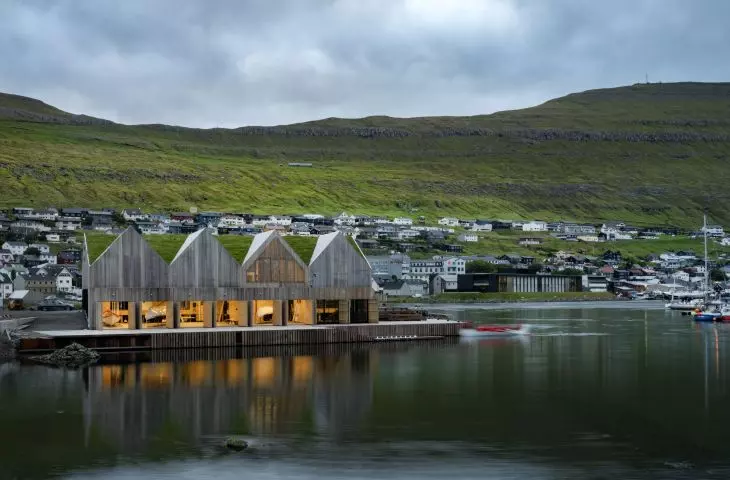Scandinavian quality {tag:pracownie} among the cold waves of the Atlantic
The harsh, cool beauty of the Faroe Islands will never be accessible to the tourist masses. You can get here from mainland Europe mainly by helicopter, as there is only one small airport in the entire archipelago. The independence of the Islands meant that in its development in Klaksvík the Scandinavian office Henning Larsen had to abandon architectural influences aimed at large metropolises. The rowing club on display is one of the steps taken to complete the urban plan in the Faroese town.
A view of Farers town. In the foreground, the rowing club from Henning Larsen
Photo credit: Nic Lehoux | © Henning Larsen
The urban plan {tag:pracownie} was focused on creating a new landmark that celebrates the Faroe Islands' sports heritage. Equipped with the latest professional equipment, the Klakslvik Rowing Club attracts locals and tourists alike with its stunning views of the picturesque landscape.
The wooden facade of the Henning Larsen Rowing Club
Photo: Nic Lehoux | © Henning Larsen
How to plan a city wisely in the Faroe Islands?
Klaksvik is the second largest city in the Faroe Islands, with a population of 5,000. The town is located on a beautiful fjord, from which you can look out over the neighboring islands while being protected from the harsh winds of the Atlantic. In the past decade, this fishing capital of the Faroe Islands has begun the journey to establish a new identity. The Henning Larsen studio spearheaded the design of a dynamic urban plan that leaves room for change to be carried over time. The essence of the plan is people, the priority is pedestrian accessibility and the incorporation of vibrant spaces, such as a children's ice rink and a rowing club, situated around a central square.
The club harmoniously blends natural elements with man-made forms
Photo: Nic Lehoux | © Henning Larsen
building new, respecting traditional - Faroese heritage
The rowing club has managed to become an important part of Klaksvík's new identity. Rowing, as the Faroe Islands' national sport, is an important part of Faroese culture, and the sport's islanders take year-round training and athletic competition with neighboring towns extremely seriously. Deeply rooted in local customs, Faroese crafts and wooden boats are emotionally and culturally important to the locals. Dating back to Viking times, wooden boats (traditionally hurled with a single axe) have been included in UNESCO's list of Intangible Cultural Heritage.
We wanted to root our project in the landscape and culture of the city. The sloping green roof and wooden facade pay homage to the surrounding natural beauty, while harkening back to the traditional architecture of the Faroe Islands. We have created a harmonious dialogue between the fjord and the man-made environment," says Ósbjørn Jacobsen, Faroese Design Director Henning Larsen.
The facade draws on local architectural solutions
Photo: Nic Lehoux | © Henning Larsen
The building was erected with pleasure in mind. The 620-square-meter structure is distinguished by a gabled roof planted with greenery and a wooden facade, which blend with the beauty of the surrounding landscape and traditional Faroese architecture.
Multifunctional design by Henning Larsen
The open, wood-filled space inside the clubhouse not only provides ample room for training, but also provides a pleasant setting for communal coffee breaks or moments of relaxation. Large windows, letting in natural light, and a mezzanine space offer visitors a wide landscape of the surrounding area, whether they are working out for a workout or just passing through the building.
In addition to a sports center, the club is a tourist attraction and meeting place
photo: Nic Lehoux | © Henning Larsen
The rowing club also serves as an arena for public events and art exhibitions, and as a tourist attraction, proudly displaying the traditional craft of Faroese boat building. During the warmer months, the club stages a café garden with plenty of outdoor seating, thereby animating the city's social life.
Our ambition was to create more than just boat storage. The wide doors to the wooden pier and the open space inside the club were designed to be as accessible as possible to the local community, says Ósbjørn Jacobsen.
Panorama of Klaksvik. On the left you can see the roof of the rowing club designed by Henning Larsen
Photo: Nic Lehoux | © Henning Larsen
the rowing doesn't stop there
The Henning Larsen office's urban plan, now about 40-60 percent complete, calls for further expansion with pedestrian accessibility a priority. Klaksvik's urban layout was designed to be flexible and adaptable to change. The town's former post office, purchased by the municipality, will be converted into a community center.
compiled by Ania Kociucka
[based on author's description].









































































